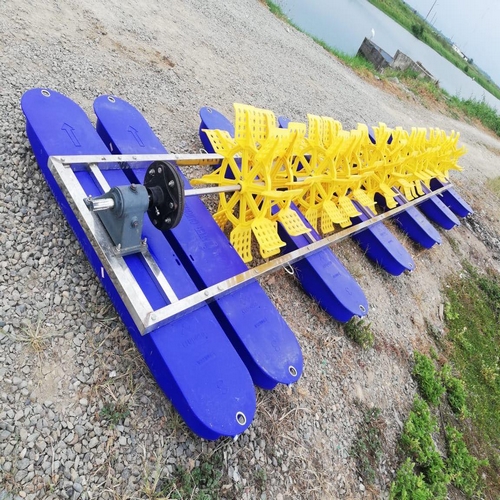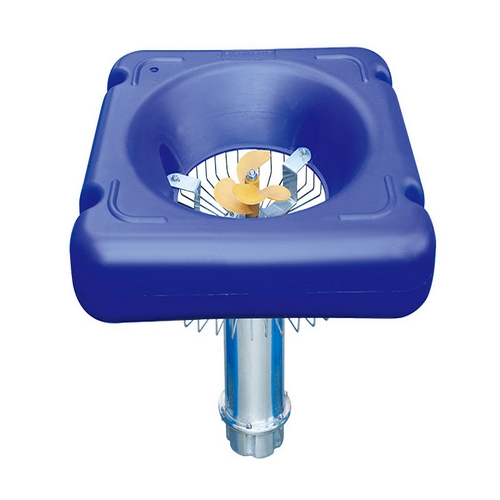Different types of aerators in aquaculture
A pond aerator is an effective device to increase the amount of dissolved oxygen in aquaculture ponds. The aerator must operate deep in the pond to improve the soil quality at the bottom of the pond and avoid the production of toxic gases in the subsoil to effectively prevent the problems of tilapia and shrimp. Possibility of death from disease. The aerator is a device that quickly transfers "oxygen" from the air to the breeding water body. It can solve the problem of floating heads of breeding animals due to lack of oxygen in pond breeding, eliminate harmful gases, promote convective exchange in the water body, and improve water quality conditions. , reduce the feed coefficient FCR Feed conversion ratio, improve aquaculture productivity, thereby increasing the stocking density, increasing the feeding intensity of fish and shrimp, promoting growth, greatly increasing the unit output, and fully achieving the purpose of increasing the income of fish farming and shrimp farming.
There are many types of aerators, including impeller aerators, paddlewheel aerators, floating fountains, Oxygen Generator, and jet aerators, etc.
It is subdivided according to the mode of supplying energy. diesel engine water pump. #diesel engine paddle wheel aerator,aireador solar para piscicultura #aireadores solares para acuicultura and electric aerators.


#scott aerator #pond pump #fountain pump principle: Pump up the water with poor water quality in the lower part of the pool and spray it upward, around, or forward at high speed.

Advantages:
1.1. It can extend and expand the time and area of aeration and oxygenation in the air;
1.2 It has a good oxygenation function, which can quickly increase the dissolved oxygen content of surface water in a short period. It also has an artistic viewing effect and is suitable for use in fish ponds gardens or tourist areas.
Disadvantages:
Due to its small effective oxygenation area and poor energy consumption conversion, it is currently only used in parks, sightseeing fish ponds, small ponds, etc. It is not only beautiful, but also practical.
Principle: The centrifugal pump rotates to suck in oxygen-deficient water from the bottom of the pond and pressurizes it, accelerating the input to the jet. When the water is ejected from the nozzle, a high-speed water column jet containing a large number of bubbles is formed. This water column is injected into the pond water body and creates a Convection to achieve the effect of oxygenating the pond

Advantages:
2.1. Simple structure, can form water flow and stir water;
2.2. The jet aerator can slowly oxygenate the water body without damaging the fish's body. It is suitable for use in aquaculture hatcheries Prawn hatcheries and nursery ponds.
Disadvantages:
The oxygenation effect is not ideal. In actual production, it is often made into a jet-type oxygenation feeding boat to achieve the dual effect of adding oxygen while feeding. The oxygenation area is small, and it is easy to wash the silt from the bottom of the pool to the water surface.
3,.paddlewheel aerator #kincir air tambak #aireadores #aireadores de paletas
Principle: Two rectangular parallelepiped pontoons are used as buoyancy devices. The motor is mounted on the pontoons to drive the vertical impeller in the middle to generate water waves to achieve the effect of increasing oxygen.

Advantages:
3.1. The whole machine is light in weight, simple in structure, low in cost, and has a good oxygenation effect in shallow ponds;
3.2. It has a strong push flow ability and certain mixing ability in the middle and upper layers, which can obtain a better contact area between oxygen and water, and has high oxygenation efficiency;
3.3. Arrange more than 2 paddlewheel aerators in the pond to form directional water flow throughout the pond.

Disadvantages:
3.1. The lifting force for bottom water is not large enough, and the oxygenation effect in deep water areas is not ideal;
3.2. It is not suitable for first aid when aquaculture animals float.
Principle: The impeller sucks up the oxygen-deficient water at the bottom of the pond, and then pushes it out in all directions to make the water flow. The water under the impeller is strongly stirred by the blades and tubes, stirring up waves on the surface of the water, forming a water curtain that can be wrapped into the air. As the impeller is rotating, negative pressure is formed at the back of the stirring pipe so that the air can be sucked into the water through the stirring pipe, and it is immediately stirred into micro-bubbles to enter the pressure area of the impeller, so it is also helpful to improve the dissolution speed of oxygen in the air and improve the efficiency of oxygenation.

Advantages:
4.2 the mechanical structure is relatively simple, in the use of the process of mechanical failure rarely occurs, maintenance is more convenient, reducing maintenance costs;
4.3 in the process of use can form the upper and middle water flow so that the upper and middle water body dissolved oxygen uniformly, suitable for pond breeding and pond first aid equipment;
4.4 aeration in addition to harmful gases. Impeller aerator has a strong aeration function, harmful gases in the pond water such as ammonia, hydrogen sulfide, methane, carbon monoxide, etc. can be effectively aeration.

Disadvantages:
4.1 it must be in smooth conditions of electricity can be used, in remote mountainous areas of lack electricity, and set up wires, the cost is higher;
4.2 the oxygenator generally must be fixed at a point in the pond, change the location of the more troublesome, and the oxygenation area is limited to a certain range, for larger ponds on the bottom of the water body the oxygenation effect is poor;
4.3the aerator's float is exposed to the air all year round, after sunlight exposure, it easily corrodes and damaged, and needs to be replaced frequently;
4.4 belongs to a single point of oxygenation, and mechanical operation noise, easily affects the growth of aquatic animals and injury to aquatic animals;
4.5 the impeller oxygenator is easily to the bottom of the pond mud pumped up, not suitable for use in shallow ponds.
Principle: the use of a roots blower air blower air suspension blower or oxygen concentrator, most people use roots blower air into the gas pipeline, the gas pipeline will be sent to the air into the microporous tube, and the microporous tube will be dispersed into the water in the form of micro-bubbles air micro Bubbles float upward from the bottom of the pool, bubbles in the gas under the action of high partial pressure of oxygen, oxygen is fully dissolved into the water, but also cause the rotation of the water flow and up and down flow, the up and down flow of the water flow will be the upper layer of oxygen-rich water into the bottom, at the same time the rotation of the water flow will be the microporous tube around the oxygen-rich water outward diffusion, to achieve the uniformity of the pool water to increase the oxygenation.

Oxygen Generator for nursery


Advantages:
5.1. Power saving. The bottom of the microporous oxygenator pressure width, simple structure, easy maintenance, long service life, and the whole machine vibration is small. Practice has proved that the underwater aeration oxygenation effect is good, compared with the traditional oxygenation method, to achieve the same effect, you can save electricity 60 ~ 80%. A 3HP blower, effective oxygenation of the water surface for 2-3 hectares;
5.2 it improves the ecological environment of aquaculture water. Aeration and oxygenation at the bottom of the water body to produce a wide range of bubble flow, sufficient airflow, and large surface contact, can ensure that the bottom of the water body of dissolved oxygen in the 6.5 mg / l, to accelerates the bottom of the water body of organic matter and nitrite deposited in the oxidative decomposition of hazardous substances and can be harmful to toxic gases out of the water surface, thereby improving and stabilizing the quality of the water, for the fish vannamei to create a suitable environment for the growth of the fish, can reduce the occurrence of diseases. The occurrence of disease;
5.3 it is in favor of high-density breeding. Aeration oxygenation for the static bottom of the water to increase oxygen, the entire body of water effective dissolved oxygen is sufficient to improve the water body of the various layers of space culture object's ability to increase appetite, shorten the breeding cycle, to increase the biological load of the water body to create the conditions;
5.4 it is easy to use. Different water surface areas can be configured with different power of the fan, a fan can practice double-pond oxygenation or multi-pond oxygenation, and the main pipe, branch pipe connection is easy to replace;
5, in the water, will not leak. Compared with the traditional oxygenator, the bottom of the microporous oxygenation is piping in the water, and with the motor on the shore, there is no possibility of leakage in the water.
Disadvantages:
5.1 the first investment in the capital relative to the impeller type and other oxygenators, the cost is high;
5.2the current level of microporous technology is limited, and the production of aeration tubes, is easy to clog;
5.3 it is not suitable for deep-water ponds, generally more than 1.5 m -2.0 m water depth, pond water pressure is too high can not play a good oxygenation effect.
6. swell aerator swell aerator #water treatment

Principle: The working principle of the surge aerator is to use the floating body impeller to lift the water in the center and resonate to cause water waves to spread around.
Advantages:
6.1simple design, lightweight, power saving.
6.2 the water is not easy to use. 3, to improve the sunlight on the water body;
6.3 Improve the light intensity of the sunlight on the water body and the air-liquid contact area, promote the growth of algae, give full play to and utilize the pond's ecological oxygenation capacity;
6.4 better weather in the case of stronger oxygenation capacity
Disadvantages:
6.1 the pond is shallow surge is too large easily stirs up the water, and can not be used;
6.2 The oxygenation effect is not high in cloudy and rainy days.
